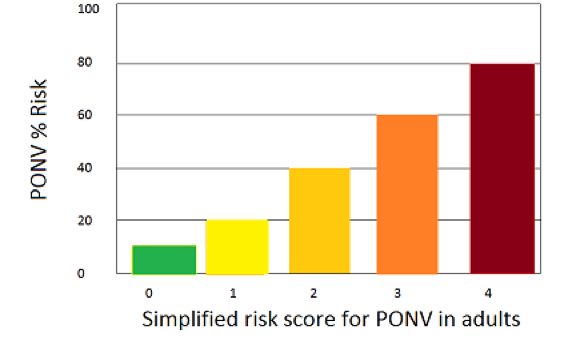This diagram illustrates various modes of acupuncture or acupressure that have been tested in clinical trials to reduce PONV. It shows the pros and cons of each intervention. Data of effectiveness are also presented. Please click on the intervention to learn more.
Types of Acupuncture/Acupressure
| Advantages |
Disadvantages |
|
Effective: (Lee et al., 2015)
Nausea (33 trials, 3846 participants) reduced from 45% to 30% (RR 0.71, 95% CI 0.62 - 0.81, p < 0.001)
Vomiting (37 trials, 4151 participants) reduced from 30% to 18% (RR 0.60, 95% CI 0.50, 0.73, p < 0.001)
|
|
|
Avoids the use of needles
|
|
| Advantages |
Disadvantages |
May be most effective of all non-invasive point stimulation: (Lee et al., 2015)
Nausea (33 trials, 3846 participants) reduced from 45% to 30% (RR 0.71, 95% CI 0.62 - 0.81, p < 0.001)
Vomiting (37 trials, 4151 participants) reduced from 30% to 18% (RR 0.60, 95% CI 0.50, 0.73, p < 0.001)
|
Requires equipment and training, units costing approximately $40 to $200 |
Able to be used over extended periods
|
|
Adjustable intensity
|
|
| Advantages |
Disadvantages |
Effectively reduces PONV following gynaecological surgery (Huang et al., 2005, Kim et al., 2003) and laparoscopic cholecystectomy (Sahmeddini and Fazelzadeh, 2008)
|
Requires staff training or a qualified acupuncturist
|
Economical: ear needles or pressure beads cost a few cents each
|
|
Individualised point selection: points can be tailored for the patient’s conditon and surgery
|
Low risk of misplaced needles
|
Remote from most surgical sites, so will not interfere with medical care
|
|
| Advantages |
Disadvantages |
Effective:
Nausea (7 trials, 896 participants) reduced from 54% to 29% (RR 0.56, 95% CI 0.39 – 0.80, p = 0.001)
Vomiting (7 trials, 896 participants) reduced from 41% to 20% (RR 0.51, 95% CI 0.34 – 0.76, p < 0.001) (Lee et al., 2015)
|
Requires training of existing staff or a qualified acupuncturist
|
Economical: Needles cost approximately 5c per needle
|
|
Individualised point selection:
Acupuncture points can be individualsed for the patient’s condition and the surgery type
PC6 + other acupoints
PONV (6 trials, 527 participants) reduced from 21% to 6% (RR 0.29, 95% CI 0.17 – 0.49, p < 0.001) (Cheong et al., 2013)
|
Requires some monitoring: there is a low risk of misplaced needles |
| Advantages |
Disadvantages |
Effective:
Nausea (7 trials, 896 participants) reduced from 54% to 29% (RR 0.56, 95% CI 0.39 – 0.80, p = 0.001)
Vomiting (7 trials, 896 participants) reduced from 41% to 20% (RR 0.51, 95% CI 0.34 – 0.76, p < 0.001) (Lee et al., 2015)
|
Requires training of existing staff or a qualified acupuncturist
|
Economical: Needle cost approximately 5c per needle Electrostimulation units are reusable for extended periods, requiring only battery changes
|
Electrostimulation requires equipment (approximate cost $200 to $800) |
Individualised point selection:
Acupuncture points can be individualsed for the patient’s condition and the surgery type
PC6 + other acupoints
PONV (6 trials, 527 participants) reduced from 21% to 6% (RR 0.29, 95% CI 0.17 – 0.49, p < 0.001) (Cheong et al., 2013)
|
Requires some monitoring: there is a low risk of misplaced needles |
Adjustable intensity: stimulus intensity can be adjusted to suit individual tolerance
|
|
| Advantages |
Disadvantages |
Effective: (Shiao and Dune, 2006)
Nausea (18 trials, 2152 participants) reduced from 36% to 24% (RR 0.60, 95% CI 0.53 – 0.69, p < 0.001)
Vomiting (19 trials, 2451 participants) reduced from 20% to 15% (RR 0.54, 95% CI 0.45 – 0.64, p < 0.001)
Rescue antiemetics (17 trials, 2156 participants) reduced from 22% to 13% (RR 0.62, 95% CI 0.52 – 0.74, p < 0.001)
|
Acupressure wristbands may not be suitable for those with large wrist circumference, wrist injuries or pain |
Economical:
Acupressure wristbands cost approximately $5AU each, and can be used for extended periods
|
Wristbands may not be practical when multiple intravenous or intra-arterial lines are in place |
|
Negligible risk:
There is no skin penetration, therefore, no risk of infection.
Wristbands are unlikely to be misplaced.
|
|
Well tolerated:
Patients may feel acupressure is more comfotable than acupuncture.
|
|
Minimal training required: both patients and clinicians can be easily trained to use acupressure.
|
|
Flexible delivery so can be tailored to circumstances:
Acupressure can be used for extended periods, Acupressure bands can be removed and replaced by patients or clinicians,
Extra manual pressure can be applied in the event of PONV,
Wristbands can be taken home with patients to continue PONV reduction following discharge when antiemetic drugs may not be available.
|
|
PC6 acupoint stimulation (all modalities)
| Advantages |
Disadvantages |
Effective:
Nausea (40 trials, 4742 participants) reduced from 47% to 31% (RR 0.68, 95% CI 0.60 – 0.77, p < 0.001)
Vomiting ( 45 trials, 5147 participants) reduced from 33% to 19% (RR 0.60, 95% CI 0.51 – 0.71, p < 0.001)
Rescue antiemetics ( 39 trials, 4622 participants) reduced from 33% to 20% (RR 0.64, 95% CI 0.55 – 0.73, p < 0.001) (Lee et al., 2015)
|
Requires training of existing staff or a qualified acupuncturist
|
Lack of side effects:
Side effects of acupuncture are mild, transient and self-limiting (Lee et al., 2015). There is no risk of drug-induced adverse effects (Streitberger and Kranke, 2011)
|
|
Economical:
PC6 acupoint stimulation is equivalent in effectiveness to commonly used antiemetics (ondansetron, dexamethasone, metoclopramide, cyclizine, droperidol, prochlorperazine: 19 trials, 1708 participants) for nausea, vomiting and the need for rescue antiemetics.
When combined with antiemetic drugs and compared to antiemetics alone (9 trials, 687 participants, PC6 plus antiemetics reduced vomiting from 33% to 18% (RR 0.56, 95% CI 0.35 – 0.91) and the need for rescue antiemetics from 32% to 20% (RR 0.61, 95% CI 0.44 – 0.86) but not nausea (48% to 38%, RR 0.79, 95% CI 0.55 – 1.13) but with studies needed to assess this outcome (Lee et al., 2015)
|
|

